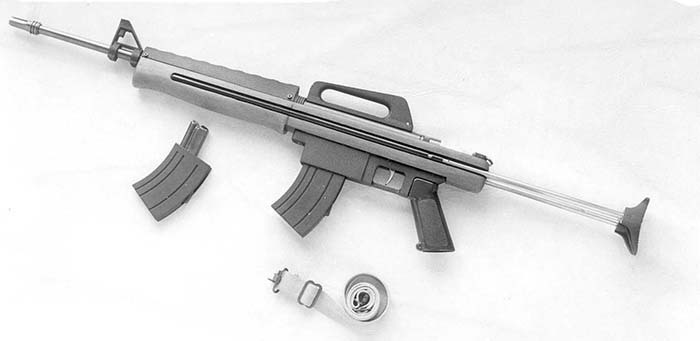An M-16R with an extensively trimmed wooden furniture as modified by local gunsmiths to create a more streamlined and lighter look-alike to fit the smaller Filipino stature.
by J.m Ramos
The Philippine islands are well-known for their hundreds of illegal underground weapon workshops which were credited to almost half a million home-made guns that were confiscated or turned over during the military weapon sweeps in 1972. Squires Bingham Manufacturing Company (Squibman) was the only legal commercial arms producer in the country. It was founded in 1905 by two enterprising US Army servicemen named Roy W. Squires and William Bingham. It was originally a print shop called Squires Bingham which was to market motorcycles and other imported goods. Between 1925 and 1941, the company began importing firearms and ammunitions. In 1941, just before the war, a wealthy Filipino named Don Selso Tuazon bought out the American interest in Squibman. However, during the Japanese occupation, the company came to a complete stop, no longer selling or importing firearms and ammunitions.
After the war, when increasing demand for weapons far exceeded the imported supply, the demand for local manufacture of these products became extremely favourable. Thus, in 1952, the decision was made to engage in arms manufacturing. From a small rented space and a purchased few machineries, begun the long history of Squires Bingham which has grown to be one of Southeast Asia’s largest weapons and ammunition producers. Soon faced with major expansion program, the company moved to its present location in Parang, (a suburb of Manila) in 1958. The factory now occupies more than 80,000 square feet of floor space. On February 1, 1980, in line with the expansion and modernization restructuring, the owners of Squibman invited new investors whose names are well known in the business circles and formed the new Arms Corporation of the Philippines (ARMSCOR). Presently, the company produces a wide variety of arms to include Colt-style revolvers; and standard and high-capacity 1911-type pistols (the latter appropriately nicknamed “Parang Ordnance”). In addition, the company continues to produce its popular pump-action shotguns and sporting rifles for both hunting and law enforcement applications.
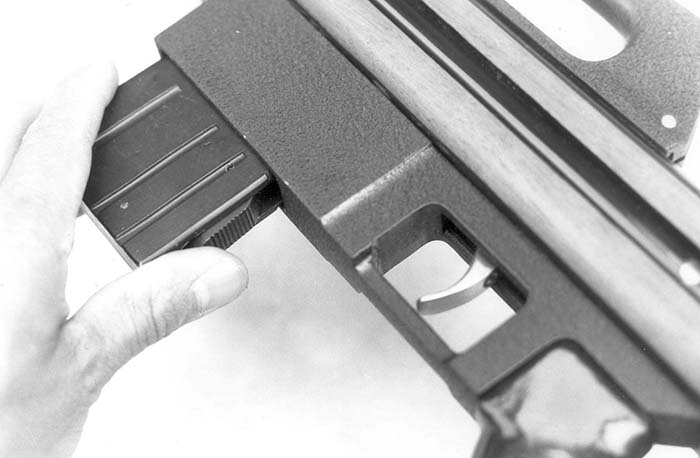
THE MODEL 20
The first .22 semiautomatic rifle produced by the company was the Model 20. It was a conventional sporter utilizing a striker-fired mechanism and had a 15-shot box-type magazine. A Cutts-Compensator-style muzzle brake was attached to the muzzle. This rifle was extremely accurate once it is sighted in properly. The machined ordnance steel used on Armscor guns is imported from Australia. Quality-wise, it is on par with most US-made commercial arms. The Model 20 continued to enjoy commercial success both locally and internationally. In addition to the standard M-20 model, a beautifully crafted “pistolized” version with a 12.5-inch barrel was also produced, although only in limited numbers and aimed primarily for the local security market. This gun features a telescoping metal stock mounted in the left side of the gun. The pistolized version is called the M-20P and is also equipped with a 15-shot magazine and a muzzle brake. The M-20P was often converted to selective-fire by local armourers and found good acceptance among rural law enforcement agencies that operate on limited budgets, many of which are still issued with antique Iver Johnson break-open revolvers.
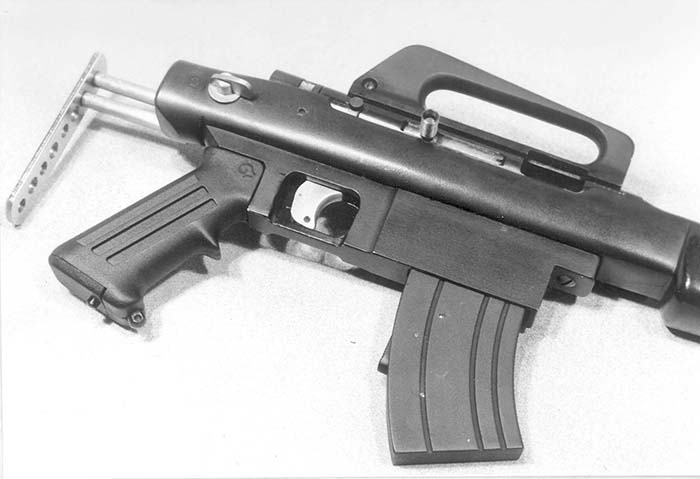
INTRODUCING THE BABY ARMALIKE – M-1622
When the Armalite-designed M16 assault rifle began replacing the old M14 in the hands of US servicemen posted at American bases, the new rifle became the talk of the town. The M16 rifle became the most coveted “must have” for the many political warlords vying for power in that turbulent era, when political assassinations by both military hit men and NPA rebel death squads became a daily headline in the media. This fascination among the locales for the M16 rifle did not go unnoticed among the marketing brass at the Armscor offices. It was this interest, spurring an unprecedented demand for this type of rifle that led to the eventual creation of Armscor’s “Baby Armalike.” The Baby Armalike became an instant sensation among weapons aficionados, more so among landowners in the rural areas infested by cattle and water buffalo rustlers. The exterior configuration of the Baby Armalike gives the impression that the operator is carrying an M16.
In order to meet the tremendous demand for the new M16 rimfire clone, for both the local and international market, the designers at Squires Bingham made good used of the original M-20 action. This decision minimized both time and retooling costs. The first model of the M-1622 featured a straight wooden stock patterned after the American assault rifle it emulated. The wood had a black lacquer finish. To give this ..22 rimfire rifle an authentic M16 styling, a new exterior housing was cast and mounted below the wooden stock. The usual plastic pistol grip was attached below the rear of the exterior housing. The M16-style carrying handle was connected to the top of the receiver, via the scope mounting grooves. A matching front sight base was attached to the barrel. A prong-type flash hider was also added for authenticity. This early production model had no upper handguard. The bottom end of the original 15-round box magazine, which protruded below the receiver, was enclosed by a wide, cast aluminum housing to give the appearance of a wide body magazine. At the rear of the magazine casing was a built-in magazine catch/release. The actual magazine catch in the form of a flat spring was attached to the trigger housing. The one-piece flat spring magazine catch was eventually replaced by a spring-loaded cast alloy component. The protruding bottom end of the catch releases the magazine when the magazine activator is depressed. The shell deflector system found at the rear of the ejection port of the original M-20 was also incorporated into the M-1622 series including the new M-50S but not with the AK-4722 models. The first production model of the Baby Armalike was introduced in 1970. Following the standard model was the compact M-16R. This version comes equipped with a spring-loaded telescoping metal stock. A push-button-type release mechanism for the stock was mounted at the rear of the stock just behind the pistol grip. The M-16R had an upper handguard added that was fabricated from a sheet metal stamping. The addition of the metal handguard, and telescoping stock added more weight and also made the gun more bulky.
The peak of exotic gun weaponry finally levelled off in the mid to late 1980s. The North American market is now virtually flooded with rimfire military clones as produced in the USA, Europe and the Philippines. In order to be able to compete with these new hi-tech entries, Armscor upgraded its M-1622 line up and added few more models in their rimfire clones, which included the Russian AK47 look-alikes, the AK-4722, AK-22F and the M-50S, and a PPSh41 SMG clone.
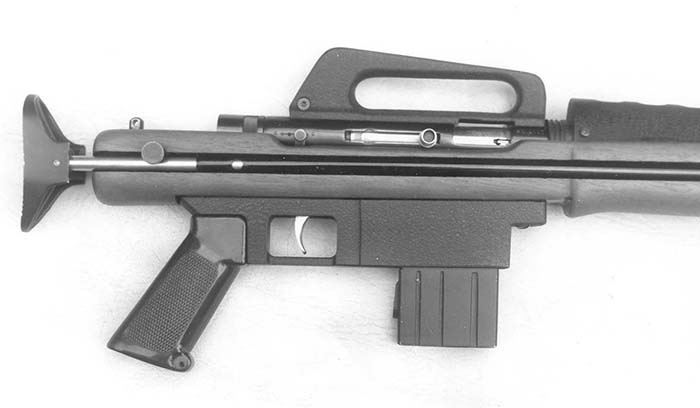
FULL-AUTOMATIC VERSIONS
Full-auto conversions of semiautomatic guns are not new to the Philippines. This art was actually taught by US military armourers fighting alongside Filipino guerrillas during World War II and carrying .30 M1 Carbines. The selective-fire M2 versions were highly favoured by the guerrillas who soon converted their issue M1s to full-automatics. After the war, these peasant armourers continued to practice their skills privately and in most cases illegally, making home-made guns as a means of livelihood. These underground-produced weapons are popularly known as the infamous “Paltiks” or black market specials. In central Luzon, the towns of Ilocos (Marcos province) are well known for their homegrown Paltiks most notably pistolized box-fed, bolt-action shotguns, revolver shotguns and break-open shotgun pistols. Commercial gun modifications were also a specialty in these mountain workshops converting almost anything that fires semiautomatic-only to selective-fire. Most of these handmade guns are crude by American standards; few specimens can be considered work of art and no two guns are alike. Over the years, I have examined numerous full-auto modifications by underground workshops of the Squibman rifles. Most common are open-bolt-types with fixed firing pins. The first one that I saw in the late 1960s was a converted Model-20. This particular specimen had a fixed firing pin.. The original striker was modified at the tip. The front blade of the striker had been trimmed off level with the breech face except a small fraction at the bottom edge, the actual portion of the part that hits the rim of the shell. This remaining small piece was rounded to form a fixed firing pin pattern with only a slight protrusion above the breech face. The rear of the striker had been cut off and a vertical pin was pressed in to lock it in place. Both the striker plunger and recoil spring assembly were assembled in the usual manner. The underside of the bolt had been filed off to create a step for the sear to engage in the open-bolt position. A new sear was fabricated; longer and higher at the rear in order to hold the bolt in the open, “ready to fire” position. The original sear was too short and low for this conversion. The original trip (disconnector) had been cut off at the top, leaving only the hooked portion to clear the new sear’s rear end extension. This gun fired full-auto-only. When I tested this rifle, it proved unreliable. The gun would usually jam an average of 3-4 times per magazine. The problems were mostly failure to feed and misfires. Failure to feed appeared to have been caused by the fixed firing pin restricting the proper seating of the rim on the breechface while the cartridge was travelling from the top of the magazine, resulting in a crushed bullet or bent cartridge case. Misfired cartridges appeared to have been caused by light hits. Overall, this was not a satisfactory modification.
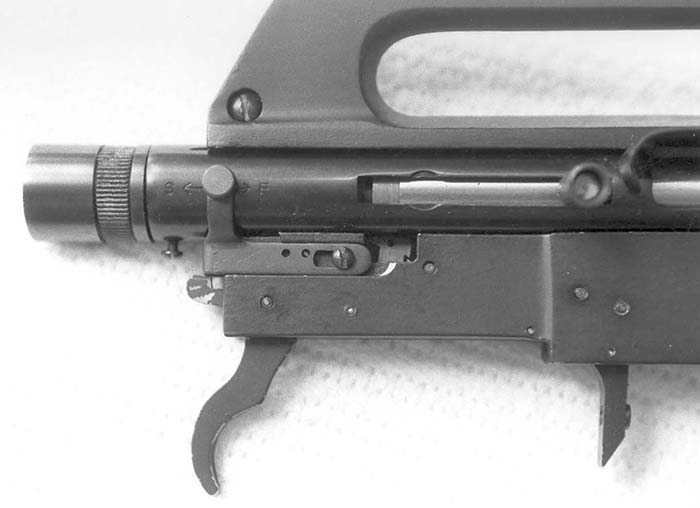
In my last visit to the Philippines in 1993, I was introduced by a friend to a Barrio captain (village official) while attending a wedding. The captain was a member of the military-trained militia originally formed during the Marcos era to help the army fight the NPA rebel groups who targeted remote areas to recruit new members. After the wedding, the captain invited me to his house and showed me his selective-fire Baby Armalike.. The captain’s gun was converted by a workshop in Ilocos province. This Armalike fired in the original closed-bolt manner, utilizing all the basic mechanism with only the addition of a long arm above the receiver and visible through the slotted portion of the carrying handle. The original sliding-type safety now had three positions instead of the usual two (SAFE and FIRE). After picking up 500 rounds of ammo from my dad’s ammo supply, I picked up the captain and drove to a nearby riverbank and to test fire his full-auto Baby Armalike. There was absolutely no recoil and the cycling was extremely smooth. Accuracy was also very good. There were only three malfunctions experienced out of the 500 rounds fired. When I noticed that the gun only malfunctioned when the magazine was fully loaded to capacity, I reduced the number of rounds to 14 and the gun worked flawlessly.
The captain allowed me to completely strip the gun at his house while we cleaned it. To my amazement, the conversion technique was incredibly simple. Everything remained the same except for a new index hole that was added between the usual safe and fire positions. To match the new middle index setting of the selector, a middle step was cut beside the usual safety clearance in the top rear of the trigger for full-auto functioning. The added step on the trigger allowed a controlled trigger pull just enough for the trip hook to pull the sear down to release the striker. The top end of the disconnector remained in line with the camming shoulder of the bolt, which, in turn, forced the trip to disconnect as soon as the bolt recoiled. When the selector was pushed all the way forward, the deep notch of the trigger lined up with the back of the selector bar and this allowed a longer pull on the trigger. In this sequence, the sear was cammed farther downward by the trip hook. In turn, the top end of the trip, with a horizontal pin (disconnector), could no longer be activated by the camming shoulder of the recoiling bolt after a shot was fired. Since the sear was now out of engagement with the striker, the long arm mounted at the top of the receiver served as a secondary sear (middle lug) and doubled as a tripper (front end toe). After a shot was fired and the bolt was travelling in counter-recoil, the middle lug of the long bar (secondary sear) would engage the striker step on top and hold the striker in a cocked position until the front end toe was forced upward by the bolt face at the last stage of its closing action.
If the selector was set to semiautomatic, the normal sear would catch the striker as soon as the secondary sear releases it during bolt closure, holding it back on cocked position until the trigger was re-pulled to fire the next round. In the full-auto setting, the same action takes place.. However, since the normal sear is out of engagement with the striker, the gun will fire automatically each time the bolt closes and the secondary sear releases its connection with the striker. The design modification was quite simple but amazingly reliable. The captain used his full-auto Armalike as a personal defence arm and as a hunting gun for small game and birds.
While these Armscor clones take a back seat in terms of exterior authenticity to their European counterparts, they still represent solid value for the money. They are economically priced, outright accurate and reliable with a proven action that remained a flagship of the company’s rimfire autoloader line for the past 40 years.
Note: Part two of this article will cover the AK-4722 Series plus another interesting full-auto conversion (with a two-piece bolt) of these .22 rimfire assault rifle look-alikes as converted by the weapon workshops in the town of Danao on Visayas Islands (the well-known site of Smith & Wesson and Colt revolver copies and full-auto shotguns).
| This article first appeared in Small Arms Review V7N6 (March 2004) |



